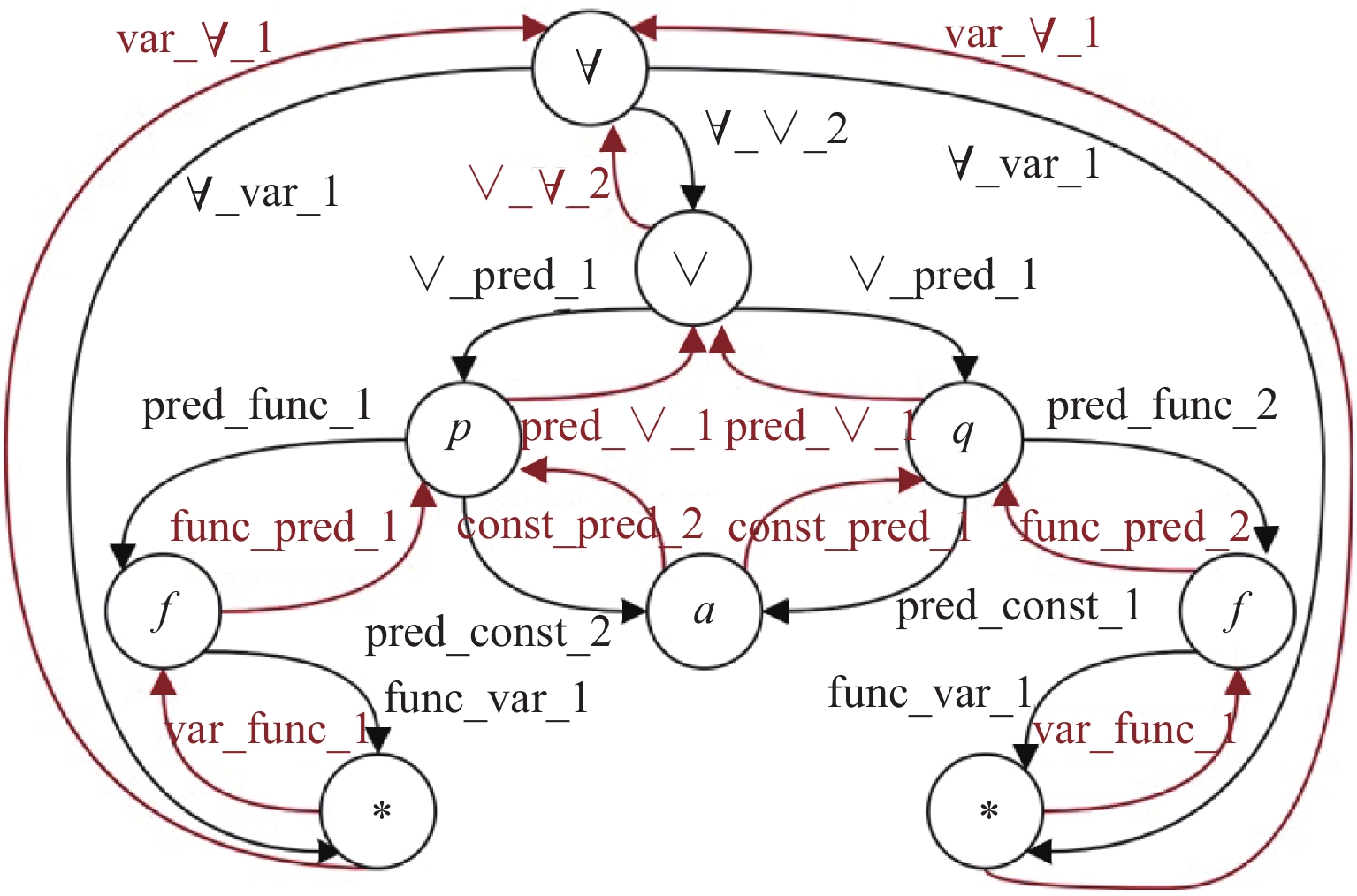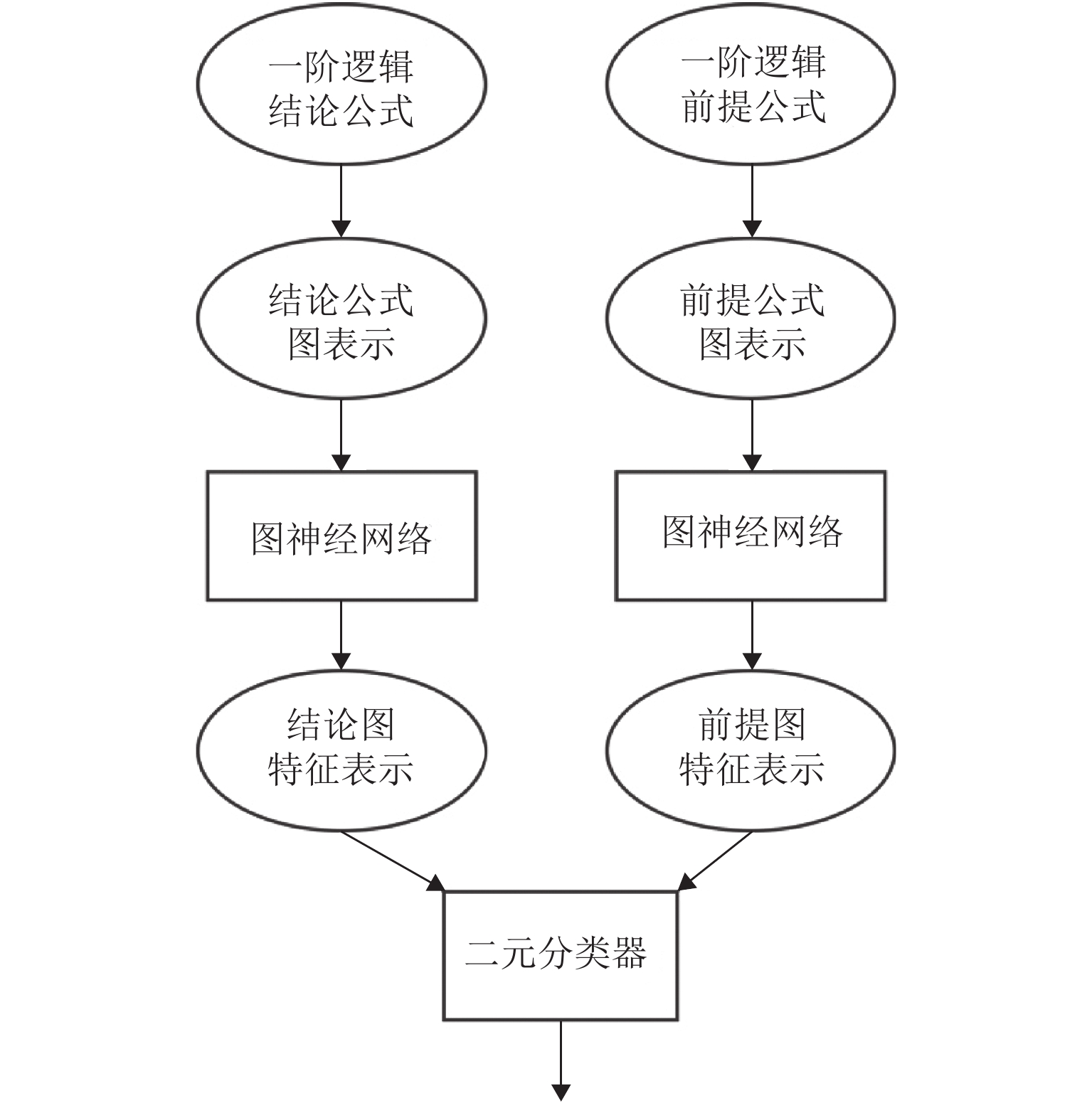Edge-Weighted-Based Graph Neural Network for First-Order Premise Selection
-
摘要:
为提高自动定理证明器在大规模问题中证明问题的能力,前提选择任务应运而生. 由于公式图的有向性,主流的图神经网络框架只能单向地对节点进行更新,且无法编码公式图中子节点间的顺序. 针对以上问题,提出了带有边类型的双向公式图表示方法,并提出了一种基于边权重的图神经网络(edge-weight-based graph neural network,EW-GNN)模型用于编码一阶逻辑公式. 该模型首先利用相连节点的信息来更新对应边类型的特征表示,随后利用更新后的边类型特征计算邻接节点对中心节点的权重,最后利用邻接节点的信息双向地对中心节点进行更新. 实验比较分析表明:基于边权重的图神经网络模型在前提选择任务中表现得更加优越,其在相同的测试集上比当前最优模型的分类准确率高了约1%.
Abstract:In order to improve the ability of automated theorem provers, the premise selection task emerges. Due to the directional nature of formula graphs, most current graph neural networks can only update nodes in one direction, and cannot encode the order of sub-nodes in the formula graph. To address the above problems, a bidirectional graph with edge types to represent logical formulae and a edge-weight-based graph neural network (EW-GNN) model to encode first-order logic formulae are proposed. The model firstly uses the information of connected nodes to update the feature representation of the corresponding edge type, then calculates the weight of the adjacent node to the central node with the updated edge type feature, and finally uses the information of the adjacent node to update the target node in both directions. The experimental results show the edge-weighted-based graph neural network model performs better in the premise selection task, which can improve the classification accuracy by 1% compared to the best model on the same test dataset.
-
表 1 MPTP2078问题库描述
Table 1. Description of MPTP2078 benchmark
条 名称 公式 结论 最小前提 最大前提 平均前提 数量 4 564 2 078 10 4 563 1 876 表 2 数据集划分
Table 2. Division of datasets
个 样本 训练集 验证集 测试集 正 27663 3417 3432 负 27556 3485 3471 总样本 55219 6902 6903 表 3 参数设置
Table 3. Setting of parameters
参数 设置 节点向量维度dhv 64 边向量维度dhe 32 迭代次数 K/次 1 学习率 0.0010 学习率衰减系数 0.1 学习率衰减步长 50 轮次/轮 100 权重衰减 0.0001 批量大小/个 8 -
[1] KERN C, GREENSTREET M R. Formal verification in hardware design: a survey[J]. ACM Transactions on Design Automation of Electronic Systems (TODAES), 1999, 4(2): 123-193. doi: 10.1145/307988.307989 [2] KLEIN G, ELPHINSTONE K, HEISER G, et al. seL4: Formal verification of an OS kernel[C]//Proceedings of the ACM SIGOPS 22nd Symposium on Operating Systems Principles. Big Sky: ACM, 2009: 207-220. [3] LEROY X. Formal verification of a realistic compiler[J]. Communications of the ACM, 2009, 52(7): 107-115. doi: 10.1145/1538788.1538814 [4] KOVÁCS L, VORONKO A. First-order theorem proving and vampire[C]//25th International Conference on Computer Aided Verification. Saint Petersburg: [s.n.], 2013: 1-35. [5] SCHULZ S. E – a brainiac theorem prover[J]. Ai Communications, 2002, 15(2/3): 111-126. [6] SUTCLIFFE G. The TPTP problem library and associated infrastructure[J]. Journal of Automated Reasoning, 2017, 59(4): 483-502. doi: 10.1007/s10817-017-9407-7 [7] KALISZYK C, URBAN J. MizAR 40 for mizar 40[J]. Journal of Automated Reasoning, 2015, 55(3): 245-256. doi: 10.1007/s10817-015-9330-8 [8] MCCUNE W W. Otter 3.0 reference manual and guide[R]. Chicago: Argonne National Lab., 1994. [9] MENG J, PAULSON L C. Lightweight relevance filtering for machine-generated resolution problems[J]. Journal of Applied Logic, 2009, 7(1): 41-57. doi: 10.1016/j.jal.2007.07.004 [10] HODER K, VORONKOV A. Sine qua non for large theory reasoning[C]//23th International Conference on Automated Deduction. Wroclaw: [s.n.], 2011: 299-314. [11] ALAMA J, HESKES T, KÜHLWEIN D, et al. Premise selection for mathematics by corpus analysis and kernel methods[J]. Journal of Automated Reasoning, 2014, 52(2): 191-213. doi: 10.1007/s10817-013-9286-5 [12] KALISZYK C, URBAN J, VYSKOČIL J. Efficient semantic features for automated reasoning over large theories[C]//Proceedings of the 24th International Conference on Artificial Intelligence. [S.l.]: AAAI Press, 2015: 3084-3090. [13] PIOTROWSKI B, URBAN J. ATPboost: learning premise selection in binary setting with ATP feedback[C]//International Joint Conference on Automated Reasoning. Cham: Springer, 2018: 566-574. [14] ALEMI A A, CHOLLET F, EEN N, et al. DeepMath-deep sequence models for premise selection[C]// Proceedings of the 30th International Conference on Neural Information Processing Systems. Barcelona: Curran Associates Inc., 2016: 2243-2251. [15] WANG M, TANG Y, WANG J, et al. Premise selection for theorem proving by deep graph embedding[C]//Proceedings of the 31st International Conference on Neural Information Processing Systems. Long Beach: Curran Associates Inc., 2017: 2783-2793. [16] CROUSE M, ABDELAZIZ I, CORNELIO C, et al. Improving graph neural network representations of logical formulae with subgraph pooling[EB/OL]. (2019-11-15). https://arxiv.org/abs/1911.06904. [17] PALIWAL A, LOOS S, RABE M, et al. Graph representations for higher-order logic and theorem proving[C]//34th Proceedings of the AAAI Conference on Artificial Intelligence. Palo Alto: AAAI Press, 2020: 2967-2974. [18] KIPF T N, WELLING M. Semi-supervised classification with graph convolutional networks[DB/OL]. (2016-09-09). https://doi.org/10.48550/arXiv.1609.02907. [19] VELIČKOVIĆ P, CUCURULL G, CASANOVA A, et al. Graph attention networks[DB/OL]. (2017-10-30). https://doi.org/10.48550/arXiv.1710.10903. [20] ROBINSON A J, VORONKOV A. Handbook of automated reasoning[M]. [S.l.]: Elsevier, 2001. [21] Rudnicki P. An overview of the Mizar project[C]//Proceedings of the 1992 Workshop on Types for Proofs and Programs. [S.l.]: Chalmers University of Technology, 1992: 311-330. [22] JAKUBŮVJ, URBAN J. ENIGMA: efficient learning-based inference guiding machine[C]//International Conference on Intelligent Computer Mathematics. Cham: Springer, 2017: 292-302. [23] COVER T, HART P. Nearest neighbor pattern classification[J]. IEEE Transactions on Information Theory, 1967, 13(1): 21-27. [24] PASZKE A, GROSS S, MASSA F, et al. PyTorch: an imperative style, high-performance deep learning library[DB/OL]. (2019-12-03). https://arxiv.org/abs/1912.01703 [25] FEY M, LENSSEN J E. Fast graph representation learning with PyTorch geometric[DB/OL]. (2019-03-06). https://arxiv.org/abs/1903.02428 [26] KINGMA D P, BA J. Adam: a method for stochastic optimization[DB/OL]. (2014-12-22). https://arxiv.org/abs/1412.6980. [27] HAMILTON W L, YING R, LESKOVEC J. Inductive representation learning on large graphs[C]//Proceedings of the 31st International Conference on Neural Information Processing Systems. Long Beach: [s.n.], 2017: 1025-1035. [28] WU F L, SOUZA A H, ZHANG T Y, et al. Simplifying graph convolutional networks[C]// International Conference on Machine Learning. [S.l.]: PMLR, 2019: 6861-6871. [29] DEFFERRARD M, BRESSON X, VANDERGHEYNST P. Convolutional neural networks on graphs with fast localized spectral filtering[C]//Proceedings of the 30th International Conference on Neural Information Processing Systems. Barcelona: [s.n.], 2016: 3844-3852. -






 下载:
下载:


